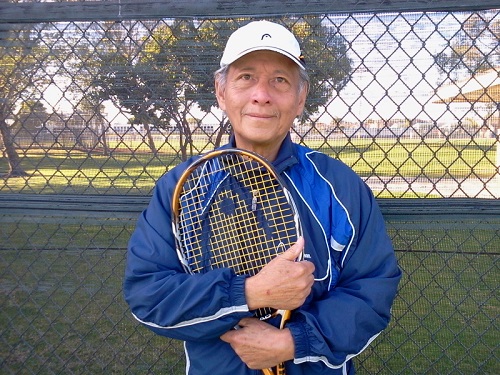By P Francis


In 2002, Oon founded the Centre For Mind Body Tennis (CMBT) in Redondo Beach to help players reach their full potential. CMBT applies the wisdom of the East to tennis, especially zen and tao. This tennis guru is a Master Professional, tester and honorary life member of the United States Professional Tennis Association and was the first Asian tennis personality to have been given this rare honour to join the ranks of Billie Jean King, Rod Laver, Fred Perry, Stan Smith, Chuck Norris, Tony Trabert, Jack Kramer and Harry Hopman.
He become a professional in 1960 before going on to represent Malaysia and Singapore between 1963 and 1968. He was vice-president of The International Soft Tennis Federation – the controlling body of soft tennis worldwide, as well as a former Davis Cup coach, including for Singapore.
Armed with a sports science/physical education diploma from the University of Adelaide in Australia, a master’s degree from the University of Oregon in the US and a Ph.D. from the University of Queensland, also in Australia, Oon has been a motivational speaker for 20 years.
In Singapore, he held senior research, information and management positions in the National Sports Promotion Board and Singapore Sports Council (SSC) 1972-1997. Having worked with Oon at the SSC in the late 1970s (I met him again in Melbourne in 2010), I have personally seen him behind the scenes diligently working and writing speeches for politicians. Beneath his stern exterior is a man with a heart. He coached and worked for the Singapore Tennis Coaches Association (STECA) in a voluntary capacity after founding it in 1977 and serving as president for several years.
Q: When and where did you first hold a tennis racket and what were the circumstances that lead to it?
A: In 1950, several years after the end of WWII in a small town Telok Anson, in Perak. Malaya. Some British civil servants were playing on the only tennis court in town. I was one of the ball boys earning a pittance. But we were given opportunities to hit around with old rackets. That was a blessing.
Q: Who coached you and was there some sort of junior programme?
A: Coaching was non-existent. Nobody volunteered to help. There was no tennis association to get a junior programme going. I was self-taught. I had a Tony Mottram book published in the 1940s. I learnt everything from that instruction book. Mottram was British and a big name at that time. This book is still in my tennis library…believe it or not.
Q:. When did your tennis really kick off?
A: In 1959, I would say. That year I enrolled as an undergraduate at the University of Adelaide. During the summer months, I had lessons from prominent Adelaide coach, John Dicker. He was an insightful coach and I credit him for launching mytennis career. In 1962/63, I was good enough to represent North Adelaide in district competition at the Memorial Drive courts. I was the first Asian playing at that level…above A grade.
Q: What happened to your tennis after your graduation from the uni?
A: I returned to Malaysia and was good enough to be selected to represent that country in international tournaments.
Q: But you also represented Singapore in the SEAP Games and other international competitions in the 1960s. How come?
A: Politics changed all that. In 1965, Singapore became a Republic and I became a Singapore citizen, earning the right to represent my adopted country. I had to renounce my Malaysian citizenship. That was the price I had to pay.
Q: You played extensively in Australia and Asia throughout the 60s when Australia ruled the tennis world. Who were the top players you competed against?
A: Players like John Newcombe, Tony Roche, Alan Stone, Colin Stubs and Ray Ruffles. In Asia, I’d competed against the legendary Indian player Ramanathan Krishnan and most of the top Asian players. I also played against Bjorn Borg (Sweden) and Tom Okker (Holland) in exhibition matches.
Q: In the 70s and 80s, you were a prominent tennis official in Singapore, serving as vice-president, president, Davis Cup captain and national coach. What was your vision for Singapore tennis then?
A: I had wanted to achieve excellence for Singapore tennis. I launched the Excellence Initiative for developing top juniors, the Team Tennis competition, and the national tennis coaches certification programme. I founded the Singapore Tennis Coaches Association to further the cause of teachers and trainers…with the aim that all these grass-root programmes will dovetail and result in a strong tennis culture.
Q: What has happened to these programmes? Have any of them succeeded?
A: To be honest, I don’t know the state and status of Singapore tennis today, as I’ve been away from the country for close to 20 years now. I can only guess it is healthy and the on-going tennis development is in the hands of forward-looking leaders.
Q: So it seems you have no contact whatsoever with the present tennis leadership. If you get an invite to return to Singapore and help out with ideas for the further development of the game, would you accept?
A: Of course, I would be pleased to help out in any way I can. I’m foremost a loyal Singapore citizen. Working in the US has not eroded my loyalty one bit or my love for my country.
Q: Then why did you leave Singapore for California? You studied sport science in Australian universities and earned your doctorate at the University of Queensland. Why did you choose the US over Australia?
A: I would have loved to work in Australia but, 20 years ago, there were few opportunities for me to function as a performance psychologist. Opportunities abounded in the US…especially California – the hotbed of American tennis.
P. Francis is an English tutor in Melbourne, who has more than 20 years’ journalism experience with newspapers, books and magazines in Singapore and Australia.


